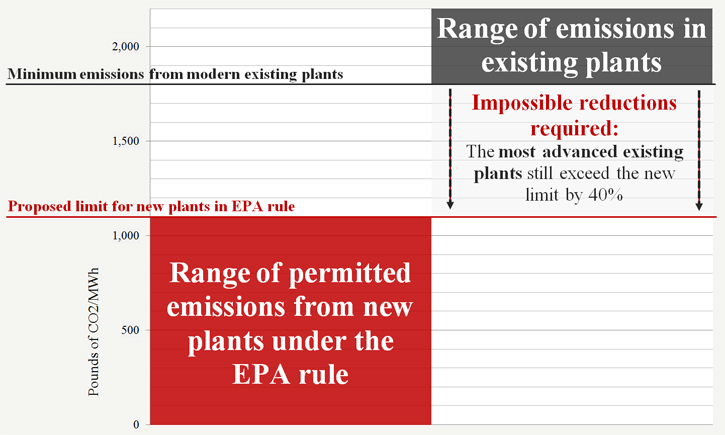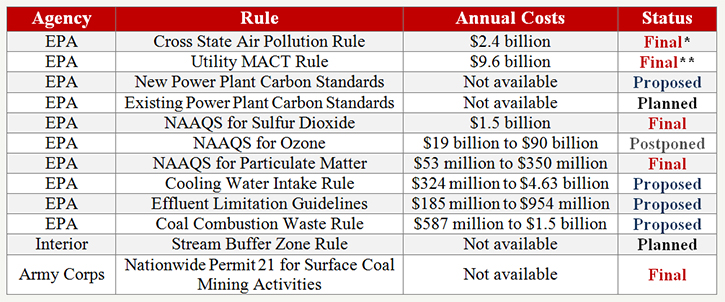Obama Administration Rigs the Market Against Coal
The Obama Administration seeks to set unattainable carbon emissions standards to ensure that no new coal-fired power plants are built in America. The Administration has been writing rules that create new market conditions to discourage coal use. Then, trying to shield itself from criticism, it cites the new market conditions as justification for additional rules. And it cooks the books of the rules’ cost-benefit analysis by including a fabricated “social cost of carbon.” Removing new coal-fired generating capacity from America’s energy mix will destroy good jobs, raise the cost of everyday living, and create little environmental benefit.
Setting An Unattainable Standard
In September 2013, the EPA proposed a rule that will require new coal-fired power plants to incorporate carbon capture and sequestration (CCS) technology, even though CCS has not been adequately demonstrated on a commercial scale.
Targets that no plant can hit

The EPA plans to limit carbon dioxide emissions from new coal-fired power plants to 1,100 pounds per megawatt-hour of electricity -- a 40 percent reduction from what today’s most advanced coal-fired power plants can deliver. Since CCS is not commercially feasible, no new coal-fired power plants could be built under the rule.
A former top Obama Administration energy official said it was “disingenuous to state that the technology is ready” because the costs of CCS are “much too high to be commercially viable.” He admitted that the technology “increases the cost of generated electricity by 80%.” Incorporating CCS also reduces a plant’s efficiency by as much as 40 percent.
EPA Moves Against Coal
The EPA primarily justifies its rule on the basis that, even in the rule’s absence, “current and projected economic market conditions” still would not support construction of new coal-fired power plants. According to the EPA’s logic, even if CCS were commercially available and utilities could comply with the rule, no company would build a new coal-fired power plant anyway because of other obstacles in the marketplace. Circularly, the Obama Administration itself erected those “other market obstacles.”
“So if somebody wants to build a coal-powered plant, they can; it’s just that it will bankrupt them.” – Barack Obama, January 2008
The recently proposed carbon emissions rule, and other regulations imposed by the Obama Administration, are among the most significant market conditions.

*Invalidated by the U.S. Court of Appeals for the D.C. Circuit in 2012. The Supreme Court will review this ruling.
**The U.S. Court of Appeals for the D.C. Circuit will review this rule.
Regulations aside, in recent years, low natural gas prices have helped persuade utilities to switch from coal to natural gas. But natural gas prices are volatile, so their market signal is fleeting. In the first six months of 2013, electricity generation from coal increased by 10 percent compared to the first six months of 2012, in response to an increase in natural gas prices. One recent survey projects the current price of $3.50 per million BTUs will climb through 2020 to between $4.50 and $7.49, ensuring coal’s price competitiveness for the foreseeable future.
Illusory and Useless Justification for the Rule’s CCS Mandate
Having manipulated the market against coal, the EPA then cooks the books by using its social cost of carbon (SCC) estimate to make the requirement of CCS technology appear more beneficial. The SCC theoretically shows the cost to society of one ton of carbon emissions, and an equal benefit from any regulation that reduces emissions by that amount.
In May, the Obama Administration raised the SCC from $22 to $36 per ton of carbon dioxide. In doing so, it inflated the benefit of its regulations by 64 percent – and therefore imposed by an equal percentage additional costs on American coal producers and consumers through the proposed rule. This increase in the SCC occurred behind closed doors, without transparency or accountability, and appears to have relied upon seriously flawed science.
According to one analysis, the American people bear 100 percent of the costs of carbon emissions rules, but only receive seven to 10 percent of the benefits -- the remainder largely accrues to other nations. As one MIT economics professor put it after studying the models used to estimate the social cost of carbon: “These models have crucial flaws that make them close to useless tools for policy analysis.” The models, he added, “create a perception of knowledge and precision, but that perception is illusory and misleading.” EPA has failed to address the serious questions about its theory.
The Administration recently admitted its failure to provide adequate opportunity for public comment on its estimate of the SCC by announcing it will hold a stand-alone public comment period on the issue. At the same time, it revised downward its estimate of the SCC in 2015 by $1 per ton of carbon dioxide to reflect “minor technical corrections.” But as long as the SCC calculations go unjustified, the EPA should not use the method to rationalize its CCS regulations for new coal-fired power plants.
For five years, the EPA has led the Obama Administration’s efforts to chip away at coal’s competitiveness. Now, it wants to cap coal-fired generating capacity by making construction of new coal-fired power plants technologically and economically impossible. Next summer, it will propose a rule forcing utilities to shut down existing coal-fired power plants. The rules are designed to work in tandem: one takes megawatt-hours of coal-fired electricity offline by forcing existing power plants to shut down; the other guarantees those megawatt-hours are never restored by prohibiting new coal-fired power plants from being built.
Reducing coal’s part in America’s power generation mix will have little impact on global carbon emissions, which increasingly come from China, India, and other developing countries. It will undercut America’s competitiveness in the global economy. The Obama Administration should stop insisting on rules that will block the use of coal. Instead, it should focus its regulatory authority on growing America’s economy and putting Americans back to work.
Next Article Previous Article
